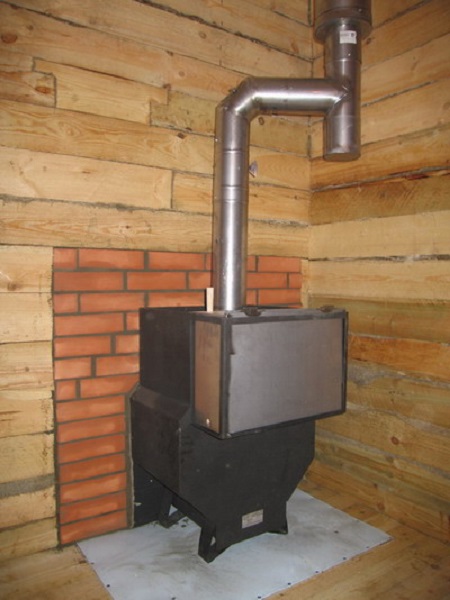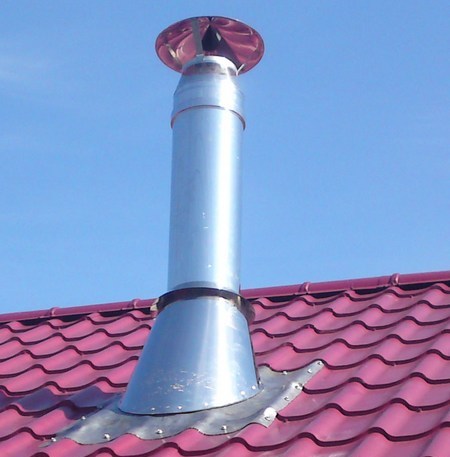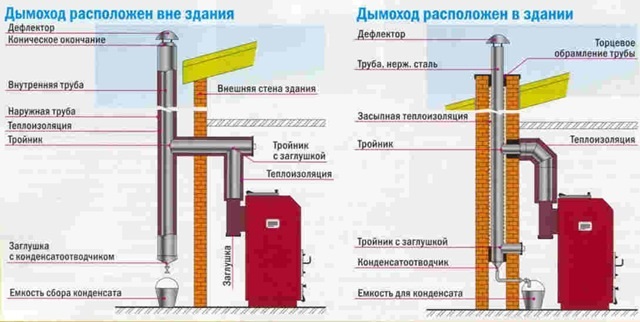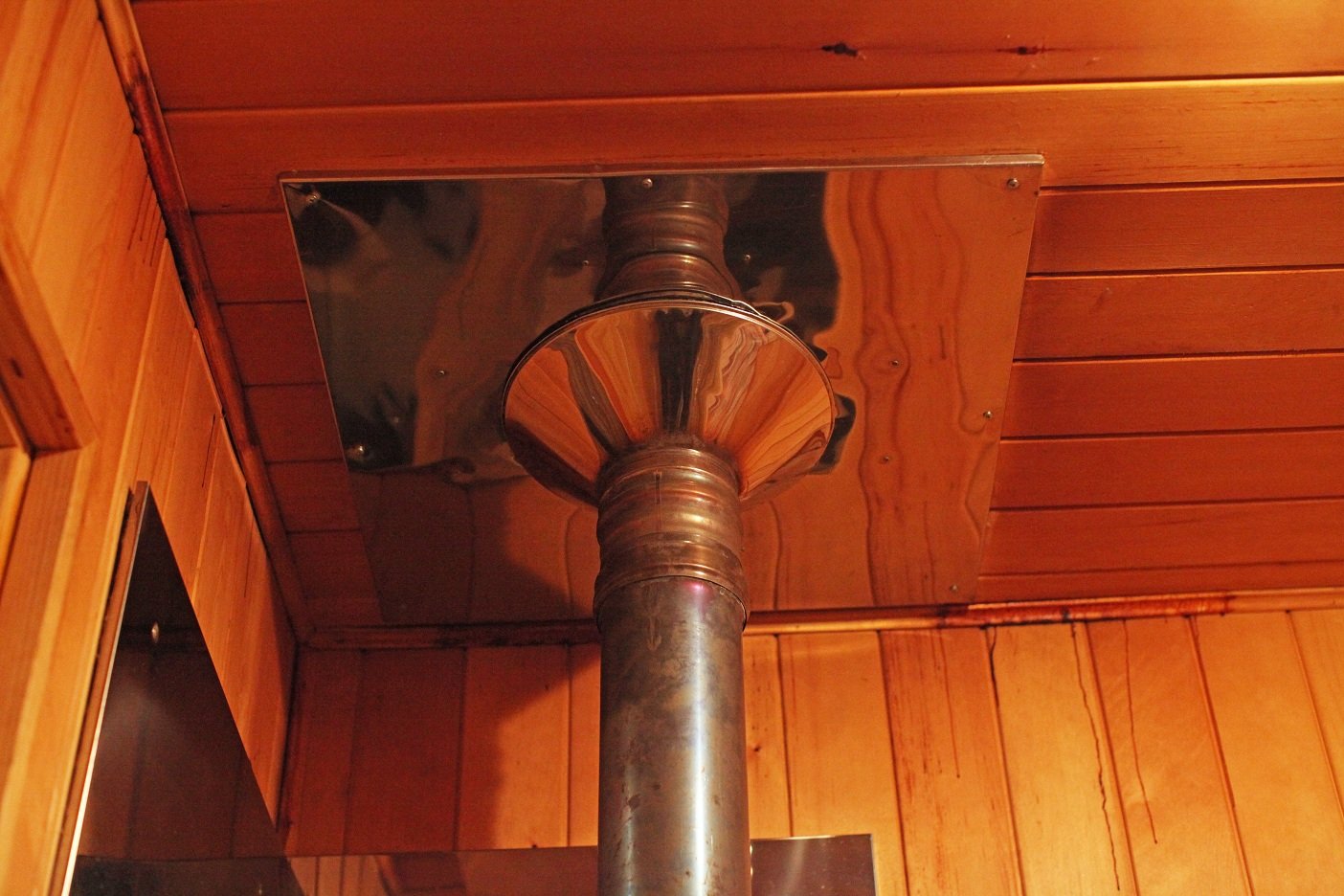Considering the design features of traditional Russian baths, one cannot ignore such a necessary component of each bathhouse as a chimney. Everyone knows the main function of the chimney - the removal of unnecessary substances from the bath in the form of dangerous carbon monoxide and unpleasant smoke.
It is impossible to imagine a bath without a chimney, in this case all the combustion products will settle in the room, and it will be very difficult to breathe air inside the bath.
Previously, such baths had a place to be, but at the present time it is almost impossible to meet them. Do-it-yourself installation of the chimney and of good quality is performed by many lovers to steam in a Russian bath.
It is worth understanding that the chimney in a modern bath is, first of all, a complex engineering structure, which should ensure reliable operation, as well as be effective for the uninterrupted operation of the remaining elements of the heating system.
Since recently the issue of private construction has grown significantly, in the wake of such popularity there are many questions about the construction of the bath: how to install a chimney from a stainless steel or laying a chimney from a brick, as well as many others. Therefore, the independent construction and design of the chimney is a very relevant topic today.
Content
A stainless steel chimney is a good option!

Stainless steel chimneys, without a doubt, have great advantages over other chimneys. They are not affected by aggressive environments (including various acids), since the stainless steel used usually contains molybdenum additives. Thanks to him, the steel has excellent acid resistance properties, and the chimney is not afraid of metal corrosion.
Stainless steel, in addition, has a small weight, which means that such chimneys can be easily installed without the additional foundation that would be needed for a brick chimney.
All metal chimneys are divided into two types:
- single layer;
- two-layer.
The easy installation of a chimney with your own hands from a stainless steel also speaks in his favor. Let us consider in more detail these two varieties.
Design features of two-layer and single-layer chimneys
For the operation of all furnaces, high-quality operation of the smoke and soot exhaust system is necessary. In this context, stainless steel chimneys will be the best solution. These versatile chimneys are able to effectively cope with the problem of removal of excess gases.
But these two types of chimneys, which were mentioned a little above, have some disadvantages, in particular, single-layer ones.
Their main drawback is the following: if the furnace or boiler operates with a high efficiency, then when removing smoke on single-layer pipes from the stainless steel, a lot of condensate will be released. Therefore, often single-layer pipes require additional insulation.

Single-layer pipes are best installed not outside, but indoors.
The difference between two-layer chimneys from single-layer chimneys is that they consist of two layers, between which a heater is laid. This design reduces condensation much better.
For the operation mode of boilers, which most often operate in alternating mode (frequent switching on for a short time period), then two-layer chimneys for a bath in this case are suitable, as well as possible, and will be an ideal solution.
The insulation layer consists of mineral wool materials, which are based on basaltic rocks. Basalt itself has very low thermal conductivity parameters, which is why it is ideal for use in chimneys and optimally helps to reduce condensation.
But before you build the chimney, you need to select it, choose a certain shape, and also make the necessary calculation of the chimney.
The shape of the chimney and its correct calculation

Although from ancient times, our ancestors built chimneys for a rectangular-shaped bath, but still the cylinder is the most effective form. It copes with the removal of all combustion products, and soot practically does not accumulate in it.
The rectangular shape of the chimney has already outlived its age and this is why: soot can accumulate in the corners of such a chimney, and this, in turn, can prevent the free exit of smoke to the outside.
Chimney diameter calculation
The cylinder was and still remains the most successful form of the chimney. This is explained by the fact that a chimney of this form most effectively removes combustion products.
Rectangular chimneys are less efficient, since in the right angles turbulences are formed, leading to the formation of soot and preventing the removal of smoke.
To make the chimney as correct as possible, it is necessary to make all the necessary calculations before installing it. This includes components such as calculating the optimum diameter for the chimney, calculating the required chimney height, and determining other important parameters.
If such a calculation of the chimney is difficult to do on your own, then it is better to invite an experienced specialist who can do this work at a high level. It will help with the miscalculation of the necessary parameters, including the diameter of the chimney, taking into account the height and future power of the furnace or boiler. Incorrect calculations can subsequently lead to unpleasant results.
A few important tips for installing chimneys
If there is a decision to build a chimney on your own, then it is necessary to take into account during construction some important points, which will be discussed further. Here's what professionals recommend on this subject:
- in horizontal sections of the chimney, the length of such segments should not be more than one meter (it is known from physics that smoke should rise up, but on a horizontal plane in large sections, it will stagnate and pass poorly, contributing to the formation of large volumes of soot);
- if the diameter of the boiler outlet and the standard diameters of the chimney pipes are different, then a pressure reducer must be used to connect the structure;
- the entire vertical part of the chimney should be collected, expanding slightly upwards, which will not allow excessive condensation to accumulate on the outer walls of the pipes;
- when installing a chimney, you need to take care of its fire safety, where the pipes come in contact with external walls (for example, of wood), you need to lay a layer of reliable thermal insulation between the pipe and the wall;
- the use of insulating materials (for example, basalt insulation) in the design of the chimney will help significantly reduce the formation of abundant condensate and can very much reduce the heating of the pipe itself;
- for quick heating of the chimney, you can use the method called “sleeve” (connecting a brick chimney to a gas boiler, inside the channel itself, which should also be made of brick, you need to install a single-walled stainless steel pipe, providing a small gap between them);
- for the removal of steam, which turns into water in pipes, it is necessary to provide a condensate drain in the chimney;
- if necessary, then you need to use a tee, a common element in many chimney designs, but it must be selected with the necessary angle for the specific case.
Rules to follow when installing the chimney
First of all, it is not necessary to use for the chimney those materials that were not originally intended for it, for example, asbestos, aluminum and so on. Corrugated pipes do not need to be used, they can cause poor smoke exhaust.

It is also worth remembering that installing a single-layer chimney from the outside of the building will not be the best solution. This can lead to the formation of a large amount of condensate, which can lead to the failure of the chimney ahead of schedule.
The load on the lower elements of the chimney should be minimal, since with a large load the whole chimney or its individual elements can fail.
It is not necessary to change the necessary diameter of the chimney without consulting a specialist, as well as to install and combine chimneys from several different stoves. This may entail the need for additional permits from regulatory authorities.
Necessary steps to create a DIY chimney
Making a chimney with your own hands is not an easy task. Especially if it is a chimney for a bath. But, nevertheless, it is quite possible, although this is a rather complex and painstaking process. It is best if the chimney is handled by experienced professionals who have experience in such work. In this case, you can be sure of the result. But still, if you decide to do it yourself, then here are some tips.
Stainless steel pipes - this is perhaps the best option for the implementation of a planned project on their own. However, if the brick chimney looks more impressive, then it is worth considering the complexity of the work to create it, which is not always possible even for experienced specialists.
Therefore, choosing the right materials for the chimney is a very important and crucial step.
Before making the calculation of the chimney (shape and its future dimensions), it is necessary to collect and analyze all available information on the subject of interest. This will allow you to understand the topic thoroughly and understand all aspects and "pitfalls".
Having thoroughly prepared, you can begin construction work. But you just need to be prepared for what to build the chimney in the bathhouse itself - this is not such an easy task. Therefore, if at some stage any difficulties suddenly arise, it is better to turn to qualified specialists in a timely manner for help, who will help solve all your problems.





Alas, no comments yet. Be the first!